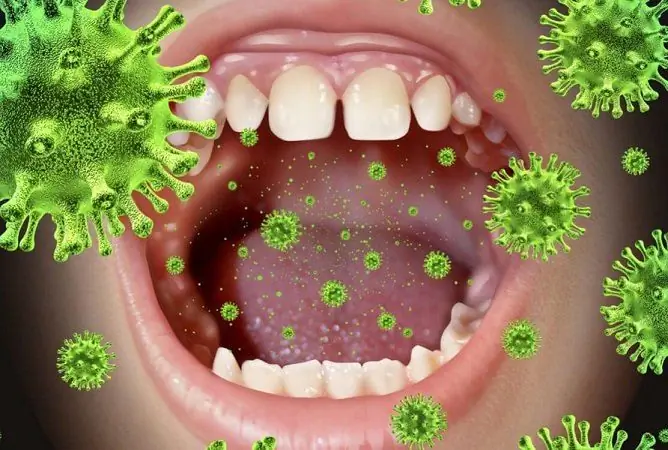- Author Rachel Wainwright [email protected].
- Public 2023-12-15 07:39.
- Last modified 2025-11-02 20:14.
Home first aid for stroke and first aid
The content of the article:
- Signs of a stroke
- First aid for a stroke to a person at home
-
Algorithm of actions while waiting for an ambulance
- First aid for hemorrhagic stroke
- Ischemic stroke: first aid step by step
- First aid for stroke
- Video
First aid for stroke, provided in a timely manner, significantly improves the prognosis. More than 450,000 people are diagnosed with strokes worldwide every year. With all the advances in medicine in developed countries, 20% of patients die in the first month after a stroke and 5-10% during the next year. No more than 40% of the survivors fully recover, 31% need constant outside care, 20% cannot move independently. Every second patient has a recurrent stroke during the first five years.

When the first signs of a stroke appear, you should immediately help the person.
The prognosis is much better in those patients who, after the first aid provided, were taken to the hospital within the first three hours from the onset of the disease. This three-hour period is called "golden time" by neurologists for saving patients from irreversible damage to the nervous structures of the brain.
It is very important that everyone knows the first symptoms of a stroke and can provide competent first aid to the patient at home before the ambulance arrives.
Signs of a stroke
A stroke is an acute disturbance of blood circulation in a specific area of the brain, leading to the development of persistent symptoms of damage to the central nervous system. They are of two types:
- Ischemic (cerebral infarction). It develops as a result of a complete or significant violation of blood flow in the pool of any cerebral artery, caused by blockage of the vessel by a thrombus (thrombotic stroke) or embolus (embolic stroke).
- Hemorrhagic (cerebral hemorrhage). The rupture of the artery wall leads to its development.
With ischemic stroke, the patient has the following symptoms:
- severe dizziness;
- gradually increasing weakness in the limbs and disorders of skin sensitivity;
- skewed face;
- Difficulty or blurry speech
- decreased visual acuity;
- violation of coordination of movements;
- convulsive syndrome.
Signs of a hemorrhagic stroke are:
- sudden severe headache;
- vomiting without prior nausea;
- paralysis of one half of the body;
- disturbances of consciousness up to its complete loss;
- distortion of facial expressions;
- salivation;
- loss of hearing and vision.
First aid for a stroke to a person at home
If the first signs of a stroke are detected in a man or woman, first aid should be provided immediately. As mentioned above, if the treatment of a disease begins in the first hours of its development, in many cases it is possible to prevent the development of irreversible disorders of brain functions.
Providing first aid (even if a stroke is suspected) should begin with calling an ambulance team. Before the arrival of medical workers, trying to help the patient, one should not give him any medicine, and even more so, perform bloodletting by piercing a vein with a needle from a syringe. Such actions can bring not benefit, but harm, cause a further sharp deterioration in the patient's condition. For example, if a person has impaired swallowing, then pills or liquid can cause airway obstruction, which, in turn, will provoke the development of both acute respiratory and acute cardiovascular failure.
Algorithm of actions while waiting for an ambulance
Depending on the type of stroke, first aid for stroke (hemorrhagic or ischemic) will have its own characteristics.
First aid for hemorrhagic stroke
- The patient is given a horizontal position with a raised headboard. The head is turned to one side.
- Provide a flow of fresh air: open a window, unfasten tight clothing.
- Removable dentures are removed from the oral cavity and accumulations of saliva, mucus, and vomit are removed from it.
- A bubble of cold water is applied to the head. Better to apply it to the opposite half of the head to the paralysis.
- Cover the patient with a blanket.
Ischemic stroke: first aid step by step
- Give the patient a horizontal position. You should not raise your head too high, it is better if it is located on the same level with the body.
- Ensure airway patency: remove dentures, clear the oral cavity of mucus and vomit, turn your head to one side.
- Provide fresh air: open the window, open the collar.
- Rub the paralyzed limbs with alcohol or massage them to improve blood flow and metabolic processes in them.
For any type of stroke, it is necessary to monitor the basic vital functions - respiration and blood circulation. With the onset of clinical death, the signs of which are cessation of breathing, cardiac activity, dilated pupils, they begin to immediately carry out resuscitation measures (artificial respiration, chest compressions). They should be continued either until breathing is restored and the pulse appears, or until the ambulance team arrives and medical workers are diagnosed with biological death.
In case of a stroke, it is strictly forbidden to try to bring the patient to life with ammonia! This can provoke a further increase in neurological symptoms, the occurrence of a seizure.
First aid for stroke
It is impossible to accurately diagnose the type of stroke at the prehospital stage. Therefore, first aid includes the so-called non-differentiated therapeutic measures aimed at maintaining cardiovascular activity, respiration, homeostasis and preventing the development of complications, which include thromboembolism, pneumonia, and airway obstruction.

It is important that the patient receives medical attention within three hours of the onset of the stroke.
If the patient is in a soporous or comatose state, inhalation of humidified oxygen through nasal catheters is indicated. In case of severe breathing disorders, tracheal intubation is performed and the patient is transferred to apparatus breathing.
In order to maintain cardiac activity, cardiac glycosides are administered intravenously. When signs of pulmonary edema appear, the use of diuretics is indicated.
At the same time, high or low blood pressure is corrected.
For the treatment and prevention of cerebral edema, the patient is given glycerin internally; in case of impaired swallowing, it is administered through a gastric tube.
In the hospital, after carrying out the necessary diagnostic measures and accurately establishing the type of stroke, undifferentiated measures begun at the prehospital and early hospital stages are supplemented with differentiated treatment.
With ischemic stroke, the patient is prescribed drugs that relieve vasospasm, improve blood rheology and metabolic processes in the brain. Treatment of hemorrhagic stroke is carried out with hemostatic agents and drugs that reduce the permeability of the vascular walls.
Video
We offer for viewing a video on the topic of the article:

Elena Minkina Doctor anesthesiologist-resuscitator About the author
Education: graduated from the Tashkent State Medical Institute, specializing in general medicine in 1991. Repeatedly passed refresher courses.
Work experience: anesthesiologist-resuscitator of the city maternity complex, resuscitator of the hemodialysis department.
Found a mistake in the text? Select it and press Ctrl + Enter.






